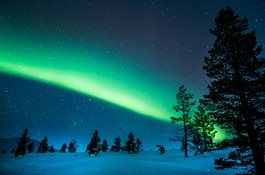
They are high up on any serious travelers’ bucket list, but unlike those monuments to mortality, the Great Pyramids of Giza or that breathtaking tribute to eternal love, the Taj Mahal, the Northern Lights are far more fickle and capricious. It can take patience, resilience, and a little bit of luck to witness to Mother Nature’s most spectacular light show.
The Northern Lights occur when solar storms send particles winging through our solar system. When these solar particles enter the earth’s atmosphere, our planet’s magnetic field excites their atoms, causing them to light up and appear to our eyes as rippling bolts of cloth, soaring arcs, or whirling dervishes. The color of the Northern Lights depends on the type of gas the solar particles encounter: low-altitude oxygen creates the most commonly seen green color, nitrogen produces the signature blues and purples, and the rare, all-red lights, often believed by the ancients to be a harbinger of war, are produced by high-altitude oxygen in the earth’s atmosphere.
The Northern Lights have always inspired myths and legends as colorful and fantastical as they are. Their Latin name, the “Aurora Borealis” refers to the union of Aurora, the goddess of the dawn and Boreas, one of the four winds. Norse mythology is rife with explanations of what - or who - the Northern Lights might be. One version states that the lights are the reflections of the spears and helmets of valiant fallen warriors, being led to Valhalla by the Valkyrie. Swedish fisherman still regard the Northern Lights as a sign of plentiful herring, while in Greenland the Northern Lights are believed to be the dancing souls of children who died at birth, happily free of earthly burdens. Iceland’s beloved storyteller Snorri Sturluson described them as “A bridge from earth to the heavens.”
Seeing the Northern Lights takes a certain amount of planning and a modicum of luck. Hedge your bet by visiting one of the Nordic countries during the optimal season for the Northern Lights, which is generally considered October - April, although there are plenty of sightings further south and outside this time slot. You can also search for the Aurora Australis in the antipodes. The Northern Lights are best viewed far from urban centers in places where there is little or no light pollution. Fortify yourself with warm clothing, hot drinks, and an SLR camera with long exposure shots and use a tripod for optimal shots; iPhones and iPads are not ideal for capturing good images of the Northern Lights unless you download and use specialty apps for the purpose.
But our advice? Just use your eyes and make an unforgettable memory.
Check the Northern Lights off your travel bucket list on one of Alexander + Robert’s carefully curated itineraries to destinations such as Finland, Lapland, and Iceland:
Finland’s Lapland in Winter includes a Northern Lights hunt by snowmobile and reindeer-pulled sleigh.